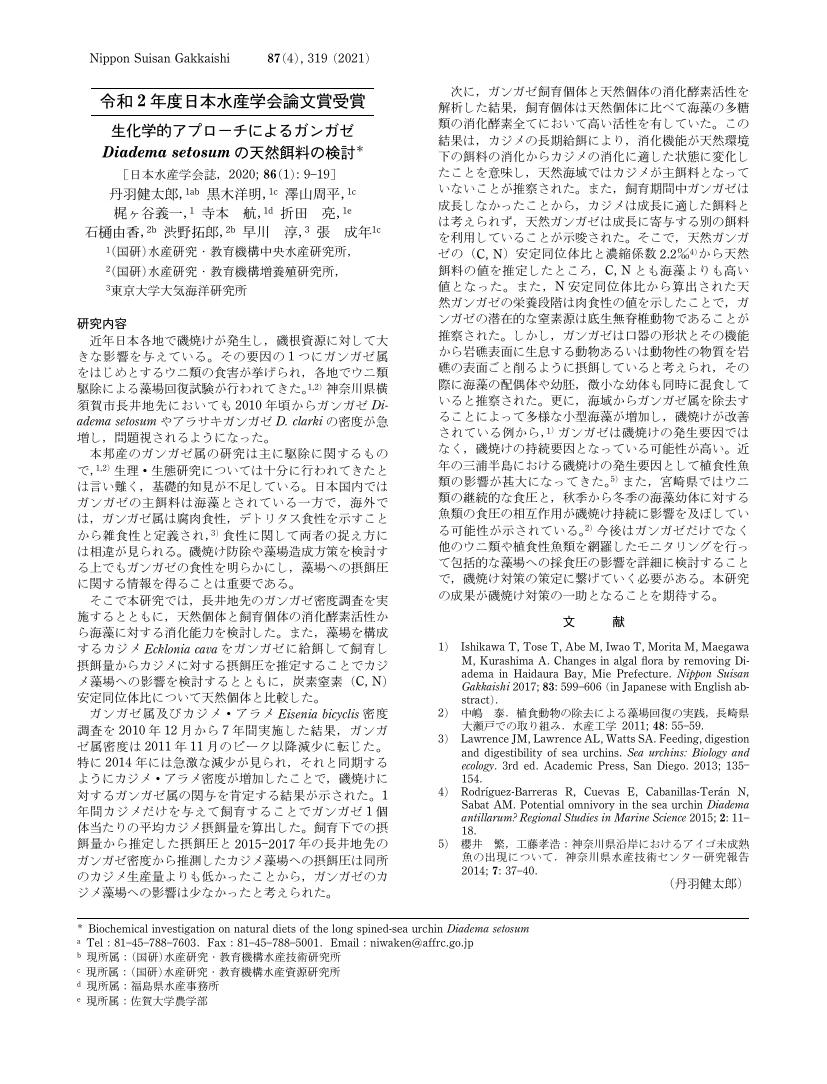1 0 0 0 OA 生化学的アプローチによるガンガゼDiadema setosumの天然餌料の検討
- 著者
- 渋野 拓郎 村上 寛 橋本 博明 具島 健二
- 出版者
- 広島大学生物生産学部
- 雑誌
- 生物生産学研究 (ISSN:1341691X)
- 巻号頁・発行日
- vol.32, no.2, pp.p93-100, 1993-12
- 被引用文献数
- 1
ニシキベラの成長に伴う食性と採餌行動の変化を、南西諸島の口永良部島の磯水域で調査した。小型魚は主に小型甲殻類(ヨコエビ類、カイアシ類、介形類、等脚類、タナイス類、クマ類)を、これらの小型の餌生物が豊富な微小藻場で摂餌していた。一方、大型になるに従い、worm類(多毛類、ホシムシ類)、貝類(巻貝類、ピザラ異類、二枚貝類)、大型甲殻類(カニ類、シャコ類、エビ類、ヤドカリ類)を含む、より大型の餌を摂餌していた。これらの、より大型の餌生物の生息宿度は微小藻場では比較的低いため、大型になるに従い採餌の範囲を拡大すると共に、より大型の餌生物が生息する石灰藻場やブダイ類のかじり跡へと採餌場所を移行させた。Ontogenetic changes in diet and foraging behavior of Thalassoma cupido were studied on the shallow reefs at Kuchierabu-jima Island, southern Japan. Small fish mainly took small crustaceans (gammarids, copepods, ostracods, isopods, tanaids and cumaceans) from algal mats, where the small prey species lived in a large numbers. While larger fish consumed correspondingly larger prey, including worms (polychaetes, sipunculids), shells (gastropods, chitons and pelecypods), and large crustaceans (crabs, stmatopods, shrimps and hermit crabs). Because the density of larger prey species was relatively low in the initial habitats foraged, larger fish shifted their foraging attention to coraline algal mats and sites scraped by scarid fish, where the larger prey species were present, as well as foraging over larger areas.
1 0 0 0 IR 口永良部島における魚食性魚類の餌分類群とサイズ組成
- 著者
- 渋野 拓郎 竹内 直子 橋本 博明 具島 健二
- 出版者
- 広島大学生物生産学部
- 雑誌
- 生物生産学研究 (ISSN:1341691X)
- 巻号頁・発行日
- vol.37, pp.17-21, 1998-12
魚食性魚類に餌として利用されている魚類の分類群とその大きさを明かにするために、南日本の口永良部島の磯において肉食性魚類の消化管内容物を調査した。調査対象種14科31種723個体中、アオヤガラ Fistularia petimba、ワヌケトラギス Parapercis cephalopunctata、アカエソSynodus ulae、ギンガメアジ Caranx sexfasciatus などの14科31種156個体によって合計339個体の魚類が捕食されていた。この中で、表層性のキビナゴ Spratelloides gracilis が最も多く利用されていた。また、口永良部島の磯においては、体長19.0mmから55.0mm、体高4.0mmから8.0mmの魚類に対する捕食圧が高いことが明らかになった。The gut contents of piscivorous fishes (14 families, 31 species, 723 specimens) collected at the reefs of Kuchierabu-jima, southern Japan, were examined to determine the composition and size of their fish prey. One hundred fifty six of predators in 31 species and 14 families, including Fistularia petimba, Parapercis cephalopunctata, Synodus ulae, Caranx seafasciatus, fed on 339 items of prey. Piscivorous fishes at the reefs ate mainly the pelagic fish, Spratelloides gracilis. The feeding pressure was particularly high in fishes with body length 19.0-55.0 mm and body depth 4.0-8.0 mm at these reefs,
1 0 0 0 石垣島浦底湾のサンゴ礁池における海水濁度の季節変動と気象
- 著者
- 高田 宜武 阿部 寧 長尾 正之 鈴木 淳 小林 都 大井 理恵 橋本 和正 渋野 拓郎
- 出版者
- The Japanese Coral Reef Society
- 雑誌
- 日本サンゴ礁学会誌 (ISSN:13451421)
- 巻号頁・発行日
- vol.2005, no.7, pp.37-48, 2005
- 被引用文献数
- 6
サンゴ礁生態系は世界的に劣化しつつあるといわれており、陸域から流入する「赤土」等の懸濁物粒子による海水濁度の上昇が、その要因の一つとして挙げられている。そこで、サンゴ礁池における海水濁度の変動レベルとその要因を知るために、石垣島浦底湾において2年間の採水観測を行った。岸近くの突堤表層では、濁度は2.26NTUを中央値とするが、変動幅が大きく、最高値92.9NTUを記録した。サンゴの生育している湾奥 (150m沖) と湾中央部 (370m沖) では、0.58NTUと0.36NTU (それぞれ表層の中央値) となった。海水濁度の変動要因として、降雨と風向の影響を解析したところ、降雨量と濁度の相関は弱いが、北西風により濁度が上昇する傾向があった。冬期に濁度が高くなるのは、冬期に多い北よりの風の影響だといえる。浦底湾のように、河川流入の影響が小さい礁池では、風波によって底質に沈殿していた粒子が再懸濁することと、表層に発達する高濁度かつ低塩分水の吹送が、礁池内の海水濁度に大きく影響すると考えられた。
1 0 0 0 IR 口永良部島におけるベラ科魚類の摂餌生態
- 著者
- 渋野 拓郎 橋本 博明 具島 健二
- 出版者
- 広島大学
- 雑誌
- 生物生産学研究 : 広島大学生物生産学部紀要 (ISSN:1341691X)
- 巻号頁・発行日
- vol.36, no.1, pp.51-56, 1997-06-30
1 0 0 0 IR 熱帯地方の海草藻場やマングローブ水域は多くの魚類の成育場か
- 著者
- 佐野 光彦 中村 洋平 渋野 拓郎 堀之内 正博 MITSUHIKO SANO YOHEI NAKAMURA TAKURO SHIBUNO MASAHIRO HORINOUCHI 東京大学大学院農学生命科学研究科 東京大学海洋研究所 水産総合研究センター西海区水産研究所石垣支所 島根大学汽水域研究センター Graduate School of Agricultural and Life Sciences The University of Tokyo Ocean Research Institute The University of Tokyo Ishigaki Tropical Station Seikai National Fisheries Research Institute Research Center for Coastal Lagoon Environments Shimane University
- 出版者
- 日本水産学会
- 雑誌
- 日本水産学会誌 = Bulletin of the Japanese Society of Scientific Fisheries (ISSN:00215392)
- 巻号頁・発行日
- vol.74, no.1, pp.93-96, 2008-01-15
- 参考文献数
- 31
